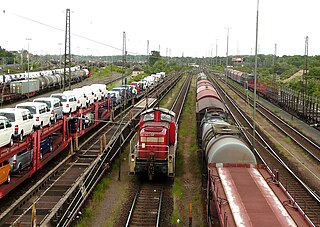
Headquartered in Kansas City, Missouri, Kansas City Southern (KCS) is a transportation holding company with railroad investments in the United States, Mexico and Panama.
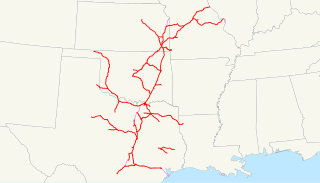
The Missouri–Kansas–Texas Railway is a former Class I railroad company in the United States, with its last headquarters in Dallas. Established in 1865 under the name Union Pacific Railway, Southern Branch, it came to serve an extensive rail network in Texas, Oklahoma, Kansas, and Missouri. In 1989, it merged with the Missouri Pacific Railroad; today, it is part of Union Pacific Railroad.

The Atchison, Topeka and Santa Fe Railway, often referred to as the Santa Fe or AT&SF, was one of the larger railroads in the United States. Chartered in February 1859, the railroad reached the Kansas-Colorado border in 1873 and Pueblo, Colorado, in 1876. To create a demand for its services, the railroad set up real estate offices and sold farm land from the land grants that it was awarded by Congress. Despite the name, its main line never served Santa Fe, New Mexico, as the terrain was too difficult; the town ultimately was reached by a branch line from Lamy.

The Missouri Pacific Railroad, commonly abbreviated as MoPac and nicknamed The Mop, was one of the first railroads in the United States west of the Mississippi River. MoPac was a Class I railroad growing from dozens of predecessors and mergers, including the St. Louis, Iron Mountain and Southern Railway (SLIMS), Texas and Pacific Railway (TP), Chicago and Eastern Illinois Railroad (C&EI), St. Louis, Brownsville and Mexico Railway (SLBM), Kansas, Oklahoma and Gulf Railway (KO&G), Midland Valley Railroad (MV), San Antonio, Uvalde and Gulf Railroad (SAU&G), Gulf Coast Lines (GC), International-Great Northern Railroad (IGN), New Orleans, Texas and Mexico Railway (NOTM), Missouri-Illinois Railroad (MI), as well as the small Central Branch Railway, and joint ventures such as the Alton and Southern Railroad (AS).

The St. Louis–San Francisco Railway, also known as the Frisco, was a railroad that operated in the Midwest and South Central U.S. from 1876 to April 17, 1980. At the end of 1970 it operated 4,547 miles (7,318 km) of road on 6,574 miles (10,580 km) of track, not including subsidiaries Quanah, Acme and Pacific Railway or the Alabama, Tennessee and Northern Railroad; that year it reported 12,795 million ton-miles of revenue freight and no passengers. It was purchased and absorbed into the Burlington Northern Railroad in 1980. Despite its name, it never came close to San Francisco.
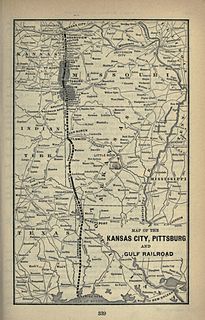
The Texarkana and Fort Smith Railway was the Texas subsidiary of the Kansas City Southern Railway, operating railroad lines in the states of Arkansas and Texas, with headquarters at Texarkana, Texas.

The St. Louis Southwestern Railway, known by its nickname of "The Cotton Belt Route" or simply Cotton Belt, is a former US Class I railroad which operated between St. Louis, Missouri, and various points in the states of Arkansas, Tennessee, Louisiana, and Texas from 1891 to 1980. In 1980 the Cotton Belt began operating the Rock Island's Golden State Route which added the states of Kansas, Oklahoma, and New Mexico to the operation. Operation of the Cotton Belt was assumed by parent Southern Pacific in 1992.

The Texas and Pacific Railway Company was created by federal charter in 1871 with the purpose of building a southern transcontinental railroad between Marshall, Texas, and San Diego, California.

The Alton Railroad was the final name of a railroad linking Chicago to Alton, Illinois, St. Louis, Missouri, and Kansas City, Missouri. Its predecessor, the Chicago and Alton Railroad, was purchased by the Baltimore and Ohio Railroad in 1931 and was controlled until 1942 when the Alton was released to the courts. On May 31, 1947 the Alton Railroad was merged into the Gulf, Mobile and Ohio Railroad. Jacob Bunn had been one of the founding reorganizers of the Chicago & Alton Railroad Company during the 1860s.
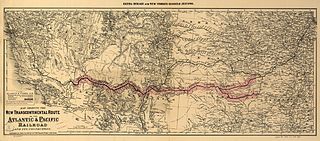
The Atlantic and Pacific Railroad was a U.S. railroad that owned or operated two disjointed segments, one connecting St. Louis, Missouri with Tulsa, Oklahoma, and the other connecting Albuquerque, New Mexico with Southern California. It was incorporated by the U.S. Congress in 1866 as a transcontinental railroad connecting Springfield, Missouri and Van Buren, Arkansas with California. The central portion was never constructed, and the two halves later became parts of the St. Louis-San Francisco Railway and Atchison, Topeka and Santa Fe Railway systems, now both merged into the BNSF Railway.
The following is a brief history of the North American rail system, mainly through major changes to Class I railroads, the largest class by operating revenue.
The following is a brief history of the North American rail system, mainly through major changes to Class I railroads, the largest class by operating revenue.
The following is a brief history of the North American rail system, mainly through major changes to Class I railroads, the largest class by operating revenue.
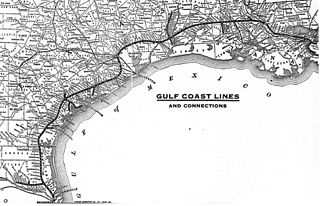
Chartered on June 6, 1903, the St. Louis, Brownsville & Mexico Railway was a 200-mile (321 km) U.S. railroad that operated from Brownsville, Texas, to Gulf Coast Junction in Houston, Texas. It served numerous towns and cities along its routes and operated a rail bridge between Brownsville and Matamoros, Tamaulipas, in junction with the Mexican government. The Brownie connected the citizens of Brownsville to nearby Corpus Christi for the first time on land rather than using water transportation.

The Gulf Coast Lines was the name of a railroad system comprising three principal railroads, as well as some smaller ones, that stretched from New Orleans, Louisiana via Baton Rouge and Houston to Brownsville, Texas. Originally chartered as subsidiaries of the Frisco Railroad, the system became independent in 1916 and was purchased by the Missouri Pacific Railroad in 1925.
The history of the Southern Pacific stretches from 1865 to 1998. For the main page, see Southern Pacific Transportation Company; for the former holding company, see Southern Pacific Rail Corporation.



